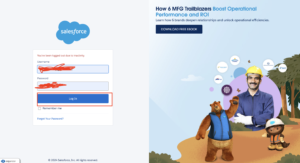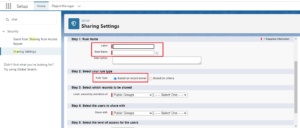In our previous blog post we had discussed about What is OWD in Salesforce. In these blog post we discuss about What is Sharing Rules in Salesforce
Contents
What is Sharing Rules in Salesforce
Sharing rules are a powerful feature in Salesforce that allow you to extend the sharing capabilities beyond the standard role hierarchy. While the role hierarchy controls data access vertically within an organization, sharing rules allow users from different branches of the hierarchy to access records horizontally. In simpler terms, sharing rules enable users from one department or team to access records belonging to other departments.
Types of Sharing Rules in Salesforce
There are two main types of sharing rules in Salesforce:
Owner-Based Sharing Rules
These rules are based on the record owner. Owner-based sharing rules grant access to records based on the owner’s role in the organization. For instance, you may want all sales managers to access the accounts owned by regional sales reps. In this case, owner-based sharing rules will automatically share those records with the appropriate users.
Criteria-Based Sharing Rules
Instead of focusing on the record owner, criteria-based sharing rules depend on field values. For example, if you have a field called “Industry” in your account records, you could create a rule that grants access to all accounts where the industry equals “Technology.” This is particularly useful when you need to share records that meet certain conditions, regardless of ownership.
How Sharing Rules Work in Salesforce
Salesforce sharing rules are defined at the object level and can be set to either Read-Only or Read/Write. These rules are applied to records that meet the specified criteria or belong to a specific owner, and they extend data visibility beyond the standard role hierarchy. This allows teams to collaborate more efficiently without violating security principles.
Owner-Based Sharing Rules: Detailed Explanation
Owner-based sharing rules are straightforward and easy to implement. They allow administrators to define access levels for records based on the role of the record owner. This is especially useful in organizations with multiple teams working on similar records but under different ownership.
When to Use Owner-Based Sharing Rules:
- When different teams require access to the same records.
- When you want to simplify data sharing for specific user roles.
Criteria-Based Sharing Rules: Detailed Explanation
Criteria-based sharing rules allow for more customization. They enable you to define specific conditions under which records are shared, based on their field values. This is particularly useful for companies that want to share records dynamically based on changing business needs.
When to Use Criteria-Based Sharing Rules:
- When you need to share records that meet specific conditions.
- When ownership is irrelevant, but field values are critical.
Creating Sharing Rules in Salesforce
Step-by-Step Guide to Creating Owner-Based Sharing Rules:
Login to Salesforce Account

Click Gear icon Navigation to Salesforce Setup

Search Quick find Box in Sharing Setting

Select New

Select another rule Based on Criteria

Click Save Button
Differences Between Sharing Rules and Role Hierarchy
While both sharing rules and role hierarchies are used to control access, they serve different purposes. Role hierarchy works in a top-down structure, automatically granting access to users higher up in the hierarchy. On the other hand, sharing rules are more flexible, allowing horizontal sharing across the hierarchy.
Common Use Cases for Sharing Rules in Salesforce
- Sharing records between different departments (e.g., sales and marketing).
- Granting access to temporary teams or external consultants.
- Ensuring specific field values trigger automatic record sharing.
Best Practices for Managing Sharing Rules
- Keep it simple: Overcomplicated sharing rules can lead to confusion and potential security risks.
- Test before implementing: Always test sharing rules in a sandbox environment before rolling them out to production.
- Regularly audit: Ensure that sharing rules align with current business needs by auditing them frequently.
Troubleshooting Common Issues with Sharing Rules
Sometimes, sharing rules may not work as expected due to conflicting access settings or overlooked permissions. Always check:
- User profiles for correct permissions.
- Role hierarchy to ensure there are no conflicts.
- Record ownership for accurate rule application.
Impact of Sharing Rules on Record Access
Sharing rules provide flexibility in extending access, but they don’t override more restrictive access settings such as organization-wide defaults or field-level security.
Auditing and Monitoring Sharing Rules in Salesforce
Regular audits of sharing rules ensure that they comply with security policies and meet business requirements. Salesforce provides audit tools and reports to monitor sharing rules for performance and compliance.
Conclusion and Final Thoughts
In conclusion, Salesforce sharing rules are a vital component of data security and collaboration. By providing flexible and customizable ways to share records, they help organizations maintain a secure yet efficient CRM environment. Whether you’re using owner-based or criteria-based sharing rules, understanding how to configure and manage them is crucial for maximizing Salesforce’s potential.
We want to more about What is Sharing Rules in Salesforce Click Here
FAQs
What is the difference between sharing rules and organization-wide defaults?
Organization-wide defaults set the baseline access, while sharing rules extend access beyond those defaults.
Can sharing rules be used to restrict access?
No, sharing rules can only be used to grant additional access, not to restrict it.
How do you monitor sharing rules in Salesforce?
You can monitor sharing rules using Salesforce’s auditing tools and by reviewing sharing reports.
What happens if sharing rules conflict with other access settings?
Salesforce applies the most permissive access rule, allowing more visibility if sharing rules conflict.
Are sharing rules available in all Salesforce editions?
No, sharing rules are not available in Salesforce Essentials but are included in higher editions like Professional, Enterprise, and Unlimited.
In our next blog post we will discuss about What is Custom Buttons in Salesforce








Add comment